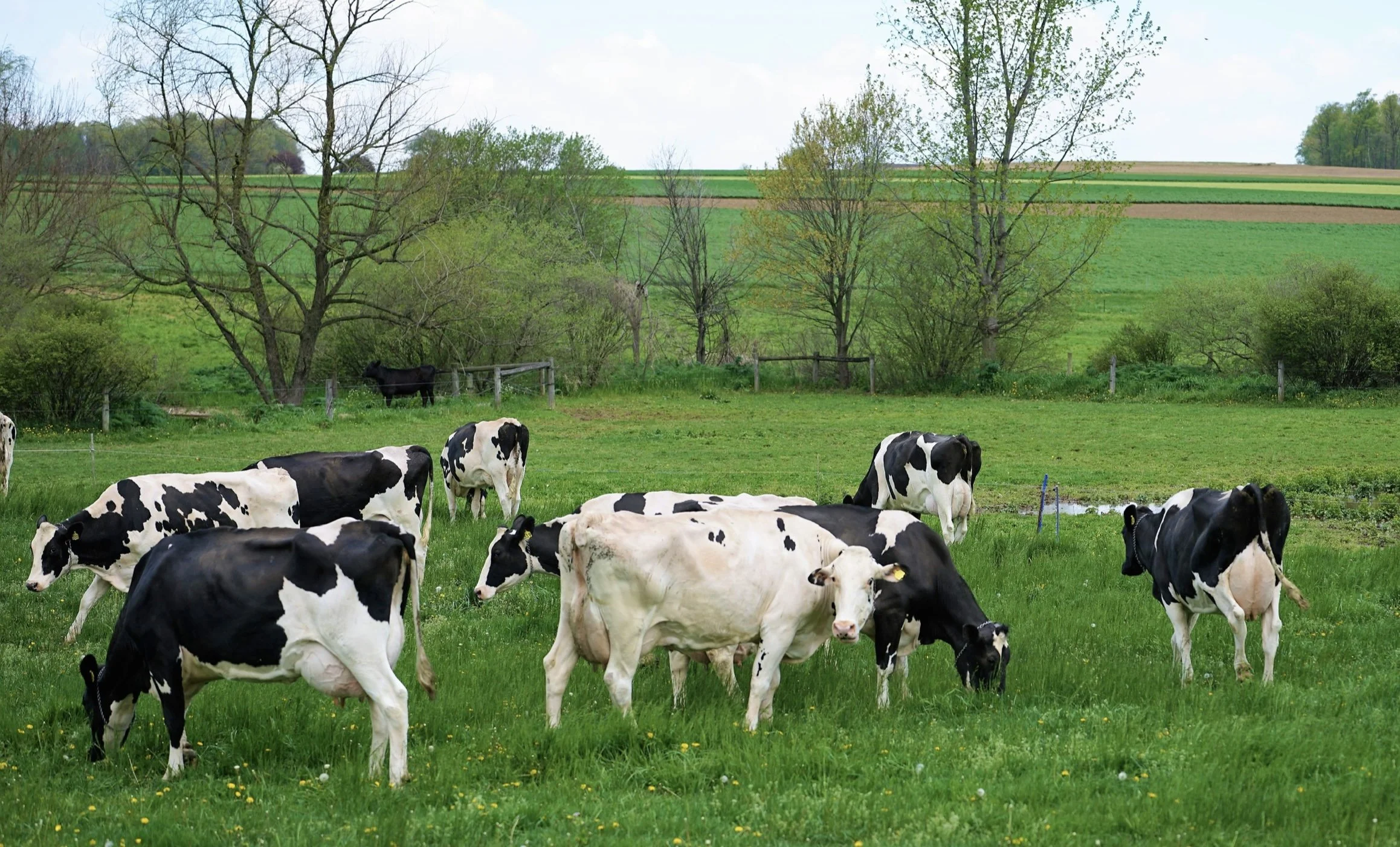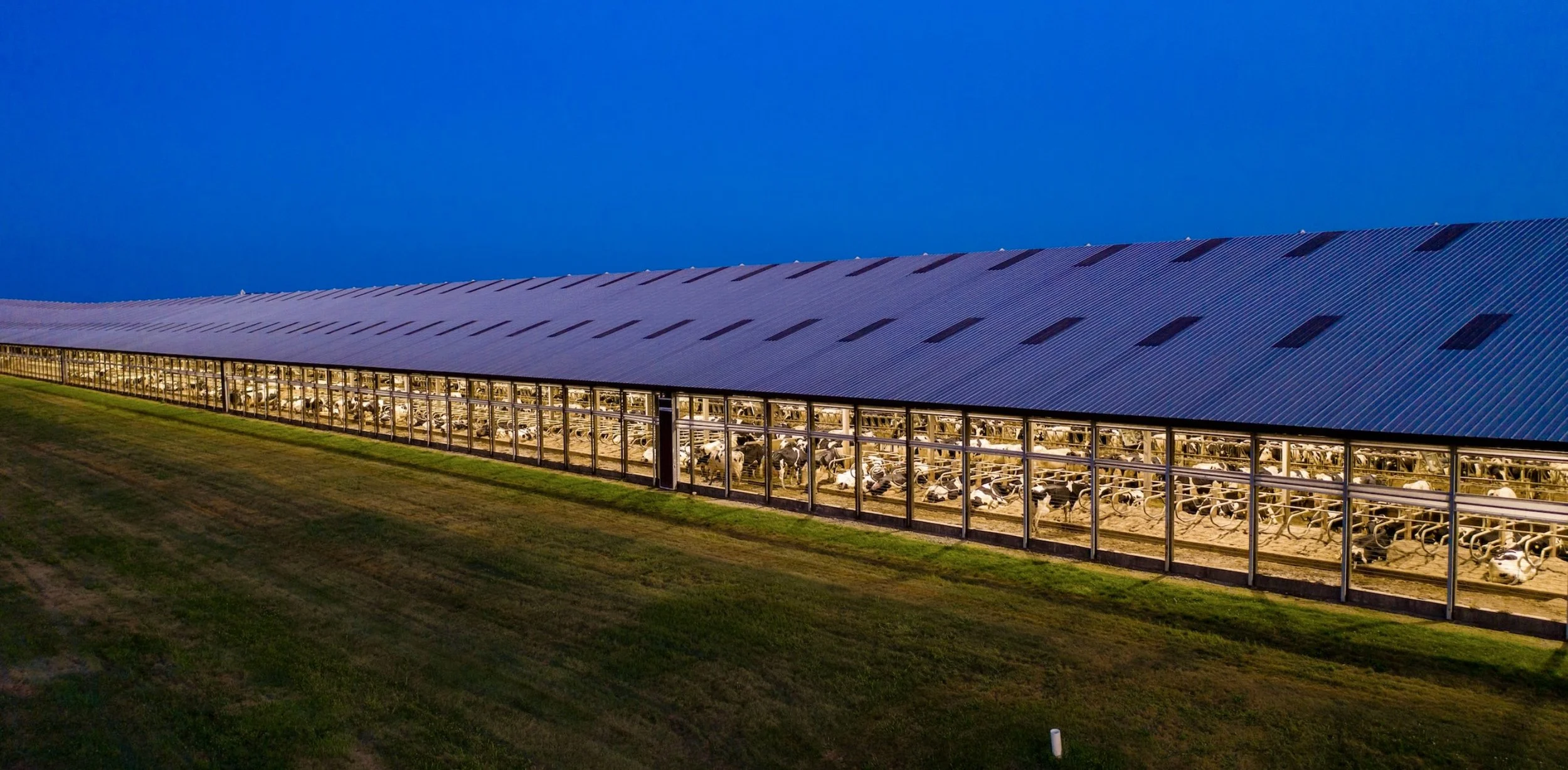By Jessica Scott-Reid
Jessica is a Canadian writer, animal advocate and plant-based food expert. Her work appears regularly in media across Canada and the US.
Dairy companies often like to include images of happy cows on their products. Cartoon depictions of smiling cows grace milk cartons while imagery of peaceful cattle dotting bucolic pastures wrap cheese. Dairy is synonymous with the cows it comes from, with many consumers never questioning how or why cows make milk --'They just do and always have!' Except, that’s not really the case. What goes on behind the closed doors of milking sheds—which have now become massive industrial warehouses—looks nothing like the re-assuring images we see on the packaging.
Dairy factory farms now regularly hold from 1,000 to 5,000 cows, including this operation in Illinois. Photo: James Baltz on Unsplash
Like other mammals, including humans, cows don't just make milk, they only do so after giving birth. And just like humans and other mammals, that milk is not produced forever; it eventually slows and stops. In order for the dairy industry to have a constant supply of milk, cows must be repeatedly impregnated, typically by a farmer through artificial insemination, and they give birth about once per year. This usually goes on for about 2-4 years.
What has been described as “the dirty secret” of the dairy industry, is what happens to all those babies, who we don't usually see in the happy marketing images.
A dairy calf chained to a veal crate throughout the cold winter. Photo: Jo-Anne McArthur, We Animals Media
Calves produced by the dairy industry are routinely removed from their mothers, often within hours of being born. The milk meant for them is rerouted for human consumption. Once removed, those calves have one of three fates, mainly determined by their sex and monetary value. While most female calves are redirected back into the dairy industry, males (aside from the few selected for breeding) are deemed to have little to no value and are either briefly raised and slaughtered for veal, or immediately killed and disposed of.
For mother cows in the dairy industry there is only one fate, and according to a recent report by World Animal Protection (WAP), that fate is “a sad and overlooked reality.” The report, published earlier this year, details the treatment of cows in Canada who are removed from milking herds “due to health or reproductive problems, or reduced milk production,” before they are inevitably butchered for meat. The industry calls these animals “cull dairy cows," and what WAP found is a variety of animal welfare concerns, “from painful health conditions to long-distance transport and neglect.”
Diary cows on a transport truck arriving at a Toronto area slaughterhouse. Photo: Louise Jorgensen, Animal Sentience Project, We Animals Media
According to inspection reports from the Canadian Food Inspection Agency, which oversees farmed animal transport in Canada, “a shocking 24% of vehicles inspected contain cull dairy cows with welfare concerns,” says WAP, “including those who are downed, lame, and emaciated.” These animals, the report explains, “are typically sent to auctions to be sold before being shipped long distances to slaughter, sometimes enduring lengthy journeys to slaughter plants in the United States. At these auctions, cull dairy cows may languish for days with little or no food, water, or milking. This can lead to painful udder engorgement, making an already difficult situation even worse.” WAP says the industry, producers, processors, government, and buyers are all failing cull dairy cows. “It's time to shine a light on the neglected welfare of cull dairy cows and work towards better treatment for these vulnerable animals.”
Two dairy cows with full udders wait in a holding pen at a livestock auction in Ontario. Photo: Louise Jorgensen, Animal Sentience Project, We Animals Media
Another aspect of the dairy industry that needs to be revealed, is its environmental impact. While most conversations around cows and their significant contribution to the climate crisis tend to focus on beef production, less often do we consider that dairy cows cause many of the same problems. According to the BBC, the dairy industry’s emissions were “equivalent to more than 1,700 million tonnes of CO2” back in 2015, which made up “3.4% of the world's total of almost 50,000 million tonnes that year. That makes dairy's contribution close to that from aviation and shipping combined.” While global dairy milk consumption has gone down since then, overall dairy consumption has gone up (thanks to butter, cheese and yogurt), so the industry’s harmful impacts continue to increase.
Source: Institute for Agriculture and Trade Policy
And it's not only the atmosphere being negatively impacted by dairy production. In the US alone, dairy cows use up approximately 1,410,000,000 litres of water every single day to make milk, and then create nearly 400,000 tons of waste. This all wreaks havoc on waterways, ecosystems and wildlife.
Greenhouse gas emission impacts are measured per litre of milk and include land use change, on-farm production, processing, transport and packaging. Source: Poore and Nemecek 2018, Our World In Data, University of Oxford
Thankfully, there is now an abundance of alternatives available for milk-lovers looking to cut their eco-impact and spare cows the misery of living life in the dairy industry. Milks made from oats, sesame seeds, soy, hemp or peas, fortified with vitamin D (as dairy milk is), B12 and calcium offer similar nutritional benefits as cow milk. And, according to one Oxford study, producing a glass of any plant-based milk results in over three times fewer greenhouse gas emissions than a glass of dairy milk.
In other words, we can put a stop to milking cows for all they’re worth.
SIGN UP BELOW FOR OUR MONTHLY EMAIL WITH LINKS TO OUR LATEST BLOGS AND A REMINDER TO FOLLOW US ON SOCIAL MEDIA FOR WAYS TO HAVE A POSITIVE IMPACT ON LIFE ON OUR PLANET.







